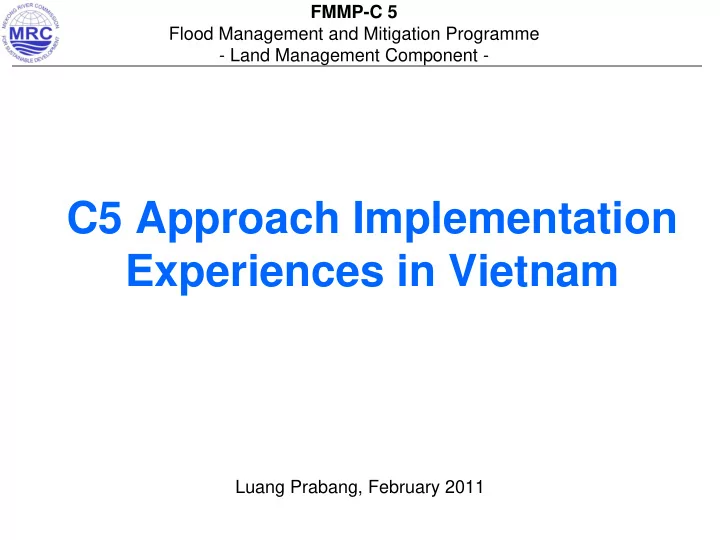

FMMP-C 5 Flood Management and Mitigation Programme - Land Management Component - C5 Approach Implementation Experiences in Vietnam Luang Prabang, February 2011
Contents • Pilot areas • Establishment of Flood marks and Bill boards • Data sources • Processing hydrological data for use with MapStats software • Mapping flood statistics • Validating the results • Conclusions and Recommendations
Pilot areas • Pilot areas in Tam Nong district - Dong Thap province and Chau Phu district - An Giang province. • Every year, the study area usually flooded from August until November
Establishment of Flood marks and Bill boards • 16 flood marks in Tam Nong • 22 flood marks in Chau Phu
Establishment of Flood marks and Bill boards • 2 bill boards at Chau Phu • 2 bill boards at Tam Nong
Data sources • DEM – DEM is supported by Vietnam Remote Sensing Center (VNRSC) – Resolution: (5 x 5) m
Data sources • Daily river levels since 1979 from Tan Chau and Chau Doc • Daily records from flood marks during the flood season for 2009 and 2010 in Tam Nong and Chau Phu pilot areas
Processing hydrological data for use with MapStats software • Calculate statistics from the long river records using MainStem software
Processing hydrological data for use with MapStats software • We transfer this statistical information to the flood plains by correlation, which is defined by analysis carried out in a spreadsheet.
Processing hydrological data for use with MapStats software 3.50 Mean flood mark level (m amsl) 3.00 • Flood recessions Fitting the recession curve 2.50 parameters Tam Nong 2.00 1.50 – To predict how quickly 1.00 the floodwater recedes 0.50 Mean observed Equation – and to know when 0.00 0 10 20 30 40 50 Days after the start of draining completion of drainage 3.00 takes place 2.50 Fitting the recession curve 2.00 Mean flood mark level (m amsl) Chau Phu 1.50 1.00 0.50 Mean observed Equation 0.00 0 5 10 15 20 25 30 35 40 45 Days after the start of draining
Data for the MapStats program MapStats needs several kinds of information: Lists – district names, river stations, probabilities Classification data – to correctly interpret the maps Rasters – for topography (DTM) and sub-areas Statistical data – parameters for river statistics Correlation data – parameters for the correlation model(s) Drainage rates – recession parameters Any other sub-area data such as slope and time delay
Data for the MapStats program • Input data for MapStats software.
Mapping flood statistics • Types of maps Maximum depth of flooding * Probability of flooding Start of flooding * Date of completion of draining * Duration of flooding * *These maps can be drawn for up to 10 different levels of risk (probability of exceedence)
Mapping flood statistics • Start of flooding
Mapping flood statistics • Duration of flooding
Mapping flood statistics • Completion of flooding
Mapping flood statistics • Maximum depth of flooding
Mapping flood statistics • Maximum depth of flooding (2000)
Mapping flood statistics • Probability of flooding
Validating the results • Compare maximum depth of flooding between prediction and observation 4.00 0.25m (average 3.50 over 9 flood marks) Maximum depth flood (m) 3.00 2.50 2.00 1.50 1.00 0.50 0.00 0.000 0.500 1.000 1.500 2.000 2.500 Ground Elevation (masl) 0.11m (average over TN-MDF10 TN-MDF50 TN-MDF58 MDF2009 TN-MDF90 Linear (TN-MDF10) Linear (TN-MDF50) Linear (TN-MDF58) Linear (MDF2009) Linear (TN-MDF90) 3.00 21 flood marks) 2.50 Maximum depth of flood (m) 2.00 1.50 1.00 0.50 0.20 0.30 0.40 0.50 0.60 0.70 0.80 Ground elevation (masl) CP-MDF10 CP-MDF50 CP-MDF65 MDF2009 CP-MDF90 Linear (CP-MDF10) Linear (CP-MDF50) Linear (CP-MDF65) Linear (MDF2009) Linear (CP-MDF90) • The maximum WL at Chau Doc in 2009 is 3.52 m (Probability of exceedence is 65%) and maximum WL at Tan Chau is 4.09 m (Probability of exceedence is 58%) • The results of the analysis suggest that the MapStats analysis for Chau Phu and Tam Nong under-estimates the maximum depth of flooding (MDF) by a small amount.
Validating the results • Maximum depth of flooding (2000)
Conclusions and Recommendations • Pilot areas have dike systems, so the result of some types of maps such as the Start of flooding, Completion of flooding, Duration of flooding... may be affected by the flood prevention in August and pumping in November. • Because of short measured data in the flooded area (2009 and 2010), so the input parameters for the MapStats software may not be accurate. It is therefore important that the observations continue, and that they are used to evaluate and continually improve the quality of predictions. • Results calculated maximum depth of flooding is quite consistent with the measured data. • Five types of maps, which are made by MapStats software, are very useful for Agriculture and land management, Infrastructure planning (roads, embankments, public buildings) and Flood awareness and mitigation. Thus, we propose to continue this study apply to other areas in Vietnam.
Thank you very much for your kind attention!
Recommend
More recommend